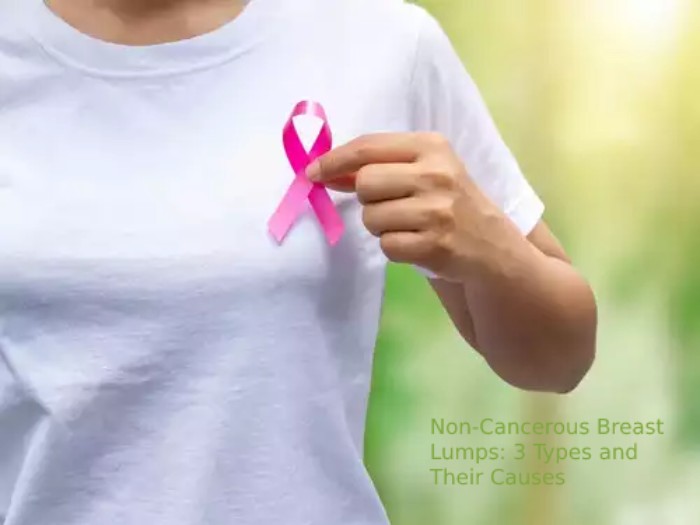Although finding lumps or other changes in your breasts can be unsettling, it’s crucial to maintain your composure. Although you might immediately think of cancer as a potential cause.
it could be helpful to know that most breast lumps are benign or non-cancerous.
A benign breast lump will typically have smooth borders and move slightly within the tissue when you press on it.
You’ll probably undergo many breast alterations throughout your life because breast tissue is extremely sensitive to the hormonal changes brought on by the menstrual cycle.
Breast infections and traumatic injuries to the breast can also result in breast lumps. If you find a strange tumor in one or both breasts, becoming familiar with common non-cancerous breast disorders might help calm you.
Non-Cancerous Breast Lumps
Some of the more typical non-cancerous breast lumps that women,
AFAB people should be on the lookout for include the following:
Fibroadenomas
Most benign breast lumps are fibroadenomas, which are quite common. Although they can emerge at any age, fibroadenomas most typically affect adults between the ages of 20 and 30. They can grow in the breast tissue at any point, and some people may even get several fibroadenomas in one or both breasts. According to recent research, most fibroadenomas do not cause cancer or raise a person’s chance of developing breast cancer.
Although they may ache or become tender during menstruation owing to increased hormone levels, most fibroadenomas are not normally uncomfortable. They frequently have clear-cut edges, are oblong or spherical in shape, and are either hard or rubbery to the touch.
They must be allowed to move freely within the breast tissue. The average diameter of a fibroadenoma can range from about the size of a marble to around 2.5 cm. However, 5 cm or larger huge fibroadenomas, as well as microscopic fibroadenomas that can only be found with breast imaging, have also been observed in some patients.
Although medical professionals can occasionally identify fibroadenomas by touch alone, they usually advise a mammography or breast ultrasound to confirm the diagnosis. Most fibroadenomas can be safely left untreated, especially if they autonomously contract or stop developing.
However, surgical excision may be advised if a fibroadenoma continues to grow or causes the patient pain and discomfort. Regular breast checks are necessary for those with fibroadenomas to ensure the lumps are not expanding.
Cysts
Oval or circular fluid-filled sacs, known as breast cysts, can form in one or both breasts due to fluid accumulation in the breast glands.
Although the specific reason for this buildup is uncertain, most medical professionals believe that the menstrual cycle’s impact on hormones is the likely culprit.
Microcystins, which are typically too small to feel, are the precursors to breast cysts. Microcysts can develop into macrocysts, which are easily palpable in the breast tissue if fluid builds up. Macrocysts can expand to a size of 2–6 cm.
Cysts can be shifted throughout the breast tissue like fibroadenomas. They frequently feel tender to the touch, but when the time for a person’s monthly period draws near, they could swell and get worse.
Breast cysts can emerge at any age, although they most typically occur in women and AFAB people in their 30s and 40s. These cysts are also among the most frequent causes of referring a patient to a breast clinic for additional evaluation.
Cysts are usually categorized into one of three categories:
Simple cysts contain fluid inside. Their walls are solid-free, thin, smooth, and consistently formed. Since these cysts are invariably benign, there is no need to be concerned.
Complicated cysts resemble Simple cysts, which differ only in the presence of minute amounts of floating solid matter. Although it is uncommon that these cysts are malignant, doctors may recommend additional testing or treatments to drain the fluid for patient safety.
Complex cysts contain more concrete walls, uneven or scalloped edges, and other solid regions. The likelihood of fluid debris around these cysts is significantly higher. Doctors frequently advise additional testing for complex cysts to rule out the presence of blood or any abnormal cells that could develop into cancer.
Necrosis of Fat
Round, firm, painless breast lumps of deteriorating and injured fatty tissue are called fat necrosis. They frequently appear in women with very large breasts or individuals who have had traumatic breast injuries like knocks or bruises.
After radiation therapy or other breast procedures, fat necrosis is another possibility. The likelihood of developing breast cancer is not increased by this specific breast alteration, which is always benign.
As long as the lumps don’t enlarge over time, cases of fat necrosis can be left untreated. Fat necrosis can sometimes even go away on its own. The lumps can be surgically removed if they spread if the affected person finds them irritating or uncomfortable.
Ultimately, consulting a physician is the only method to determine whether a breast lump is malignant. You may assist in ensuring good breast health for the rest of your life by paying close attention to changes in your breasts and immediately communicating any concerns to your healthcare professional.
Also read:- The Primary Causes of Cellulite and How to Combat It
